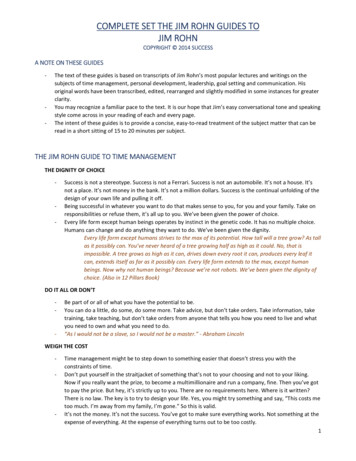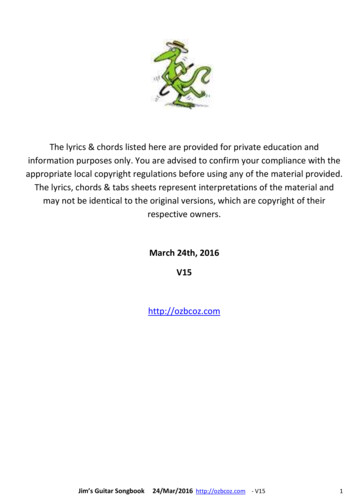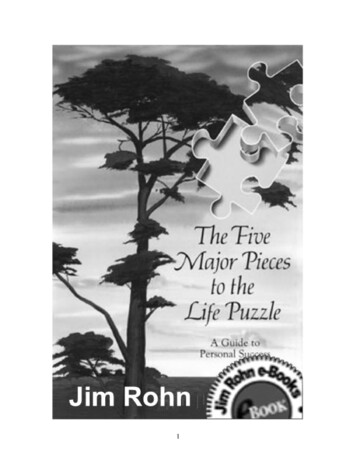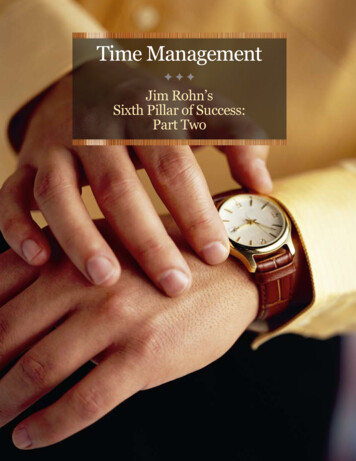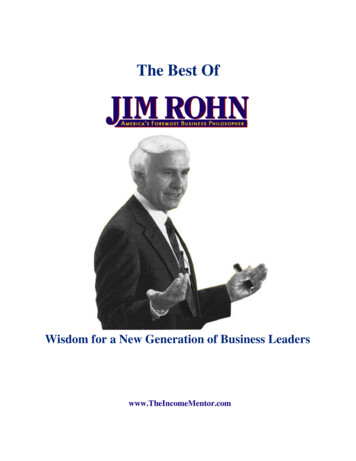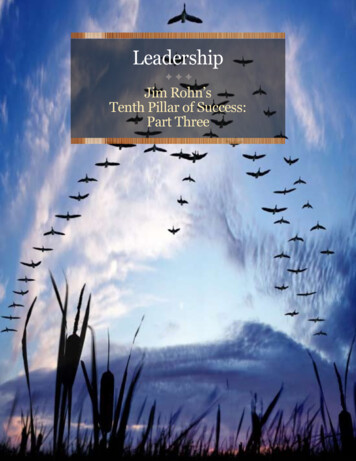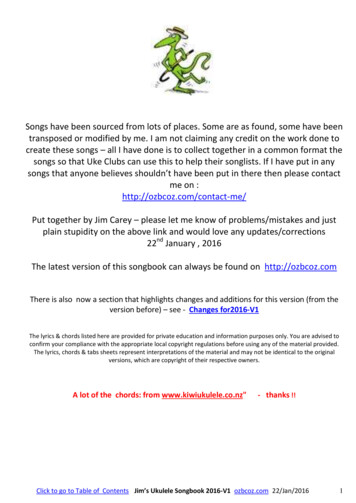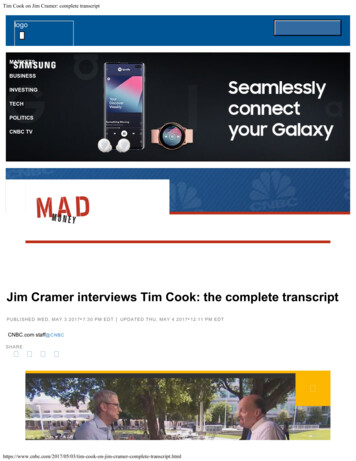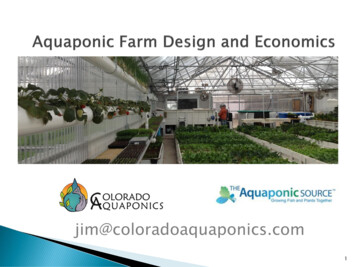
Transcription
jim@coloradoaquaponics.com1
Create a basic conceptual design for anaquaponic farmLayout fish tanks, filtration and growingsystemsDetermine plant and fish productionEstimate farm revenue and expenses2
We have a business plan!We’re raising TilapiaWater temperature is 72FDesired pH range is 6.6 to 7No artificial lights except for the nursery andmicrogreen decksColorado climateClimate controlled greenhouseMunicipal filtered water3
Business and Environmental Considerations Climate Zone Designation Local labor Permitted fish species Outlet for fish Market pricing for desired crops Proximity to markets Competitive analysis Distribution methods, channels Security Food safety regulations Licensing, wholesale, processing Insurances Business plan (whole other document) Financial Marketing Operations Human ResourcesSite Conditions Fresh water source Water quality test, flow rate, reliability,temperature Electrical service, reliability Propane or natural gas Road access Equipment delivery method Infrastructure Locally available construction, plumbingmaterials Sun orientation, obstructions,winter/summer light availability Local zoning, permitting and regulatoryrequirements Renewable energy systems Grading, fill Site drainage, water discharge Sanitary sewer Utility locates Wash station, restrooms4
Vegetables: Ideal Soil pHArugula (Roquette) 6.0 - 6.8Beans 6.0 - 7.5Cress 6.0 - 7.0Cucumber 5.5 - 7.5Kale 6.0 – 7.5Lettuce 6.0 - 7.0Mustard 6.0 - 7.5Parsley 6.0 - 7.0Pepper 5.5 - 7.0Spinach 6.0 - 7.5Tomato 5.5 - 7.5Fish: Ideal water pH- Tilapia 7.0- 7.5- Trout 7.0- 8.0- Wipers 7.0- 8.5- Catfish 5.5- 7.5- Koi 7.5- 8.05
In any aquaponic system the amount (ornumber) of plants we can grow is directlyrelated to the amount of nutrient available6
The amount of nutrient available is directlyrelated to the amount of waste the fishproduce7
The amount of waste produced is directlyrelated to the amount of feed fed8
Therefore theamount of plantsgrown is directlyrelated to theamount of feed thatenters the systemDr. Wilson Lennard9
Number and type of plants you wish to growThe area those plants need to grow (or themax area you can provide)How much fish feed the plants require fornutrient uptakeThe weight of the fish required to eat thefeedThe volume of water required for the fishbased on stocking density10
At Flourish Farmswe’ve beenconsistentlyrunning on feedrate ratiosbetween 15 to 20grams/m²/day forlighter feedingplants such asleafy greens11
12
Large water volumecontributes to thermal massand overall stability oftemperature and pHWith loss of power or pump,plants remain aliveProven through years ofresearch andcommercializationSimple harvesting andtransplanting – conveyor belt13
2,880 sq ftEmpty greenhouse with a bio secure entrance14
1,184 sq ft of DWC @ 3.5 plants per sq ft2’ aisle width5 species – PI Romaine, Bibb Lettuce, Green Star,Mustard Greens, Red Russian Kale15
1,184 s.f. of DWC 110 m² 110m² * 20g/m² 2,200 grams of feed perday (4.8 lbs) Annual feed input 1,769 lbs Tilapia Feed conversion ratio 1.5lbs of feedto 1lb of body mass (FCR .67) Annual fish production 1,179 lbs Annual Feed input x FCR of .67 Relatively conservative for Tilapia and assumes slower growth dueto lower than ideal temperature16
Average harvest weight 1.6lbs Total # of harvested fish annually 736 We will have 2 age cohorts in 2 tanks with a 36week growout (annual fish production gain 1,179lbs/1.6lbs) Harvests per year 2.9 (52 weeks/18 weeks) Weight per harvest 406 lbs Maximum stocking density .4lbs/gal Water volume for each rearing tank 1,000 gal (annual weight/2.9)17
Tank Design rules ofthumb Dia:Depth Ratio 3:1to 6:1 Hydraulic RetentionTime (HRT) in fishtanks 30 to 60 min1,000g tank @60minHRT 17gpm* Timmons, Ebeling18
More Uniform mixingLess flow short-circuiting alongtank bottomMore effective solids flushingImage credits: Timmons, Culture Tank Design,The Aquaponic Farming Course19
Radial Flow Clarifier(RFC) The PrimarySolids Removal deviceMineralization Tankfor suspended solidsBio-filter forConversion ofammonia to nitratesDegassing Tank20
Proven to be up to 85% efficient in solidsremoval*Sizing “Rule of Thumb” 4 gpm per ft² of cylindersurface area17gpm per tank x 2 tanks 34gpm total flowinto the RFC34gpm flow rate 8.5 ft² 40” diameter45 degree cone bottom idealFine the closest best fit tank – For example, 48”diameter 500 gallon 45 degree cone bottom 2005, Davidson, et al *Integrated Aqua Systems21
Radial Flow ClarifierImage credit: The Aquaponic Farming Course22
Additional treatment oflighter suspended solidspost RFC is necessary toavoid clogging and foulingof the bio filterHeterotrophic bacteriabreakdown solids and“mineralize” them intonutrients and othercompoundsControls level of denitrificationMineralization tank – brush filter23
About 3% of daily feed ends up asAmmonia-Nitrogen in the water* 4.8lbs of daily feed @ 3% 64g TAN Volumetric TAN Conversion rate (VTR) is the grams of TAN pervolume of media per day converted into nitrate Design VTR 15gTAN/ft³ Assuming granular media ( 175 ft²/ft³)* 64gTAN/15g VTR 4.3ft³ of media Media @ 50% of container volume 9ft³ or 64 gallons A 64 gallon tank 2ft diameter x 2.6ft height* Timmons, Ebeling Recirculating Aquaculture 3rd Edition24
Additional breakdown of solidsremoved from the RFCNutrient rich water can bereintroduced back into the mediabeds or used as fertilizer for soilbased agricultureWater can also be sold to otherfarmers for additional farmrevenueThis tank is an air driven brewerutilizing air from the existingblower for aeration and vortexingof solids (no additional energydemand)25
108 sq ft of media beds66 sq ft for nursery based on seedling rotation66 sq ft for microgreens under nurseryLab, sink and work surface areas26
Pricing, density, culture times and yield data are derived fromFlourish Farms in Denver, CO27
Actual planting strategy, choice of crops, and percentageallocation in the system are all up to you and the proper mixyou need to satisfy your customers28
Loss rate is the difference between the densityplanted in the rafts versus the actual sellable product29
Price, distribution strategy, customerbase, wholesale vs. retail etc. are driven byyour business plan and market forces30
100 sq ft of media beds could contributeanother 1,500 to 3,000 crops per year31
32
Total annual weight of harvested fish 1,179 lbsAverage 5 per lb for whole live TilapiaTotal Fish Revenue 5,89733
Leafy Greens in DWC 49,141 Includes seasonal production variability Microgreens 13,127 Fish Revenue 5,897 Total Revenue 68,16534
PestsStartupNutrient DeficienciesOperator skills,Management andTrainingBusiness & MarketingPlan (lack there of)Customer & pricevolatilityAvailable lightPlant speciesCulture time in system Performance of biofilterFish speciesFish feeding or notfeedingTemperature andenvironmentQuality of startsProduct handlingMonitoring controls andbackup systemsFood Safety and HACCPplanSupply chainconsistencyWater Quality
Utilities 5,082* Electricity, gas, water Supplies 8,836 Plug trays, fish feed, adjusters, IPM, packaging, parts General Admin 4,820 Licenses, insurances, professional fees Payroll 38,322 Wages, Taxes, Workers Comp Total Expenses 57,060*Based upon 40 year old Colorado greenhouse withimproper orientation. See passive solar greenhouse at theend of the presentation for better solutions36
37
38
39
41
Aquaponics and passive solargreenhouses enable truly sustainableand resilient year round foodproduction. With the right building anda thoughtfully designed growingsystem, commercial aquaponicsbecomes practical and profitable.JD Sawyer
Create, Innovate, Educate,Integrate, Evolvejim@coloradoaquaponics.com
microgreen decks Colorado climate . your business plan and market forces. 31 100 sq ft of media beds could contribute another 1,500 to 3,000 crops per year . 32 Total annual weight of harvested fish 1,179 lbs Average 5 per lb for whole live Tilapia Total Fish Revenue 5,897 33 Leafy Greens in DWC 49,141 Includes seasonal production variability Microgreens 13,127 Fish Revenue 5,897 .
